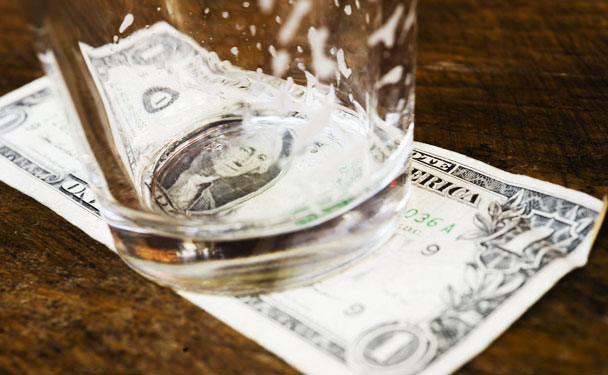Jamie Berg, an engineer way up in Portland, Maine, visits bars once or twice a week to savor a few Pabst Blue Ribbon 16-ouncers. He pays a couple bucks per beer, easy as pie. But things grow thorny when he counts his change and considers a tip.
“If it’s a nice place, well kept, with attentive bartenders and the Pabst are nice and cold, tipping $1 is about right,” says Berg, 26. “But if the bartender takes a while, the place is dumpy and I get change in the form of coins, they are getting the coins.”
For safety’s sake, he better pray he never tosses a quarter to Sam Ross.
“If your tip makes a clink on the bar, even if it’s dollar coins, you’ll get it thrown at the back of your head,” says Ross, a mixologist for New York City’s esteemed Little Branch and L.A. hot spots Sona and Comme Ça. “Under no circumstances should you leave less than a dollar bill.”
Then again, a little change is sometimes welcomed.
“Coins are legal tender. I like to apologize if I leave change, but it’s not so bad to leave it at the beginning of the night,” says Eben Klemm, a molecular biologist turned drink innovator for the B.R. Guest restaurant group. “At the end of the night, though, change will make bartenders sad: No one wants to count change.”
Tipping is the subject of passionate, conflicting and downright arbitrary opinions among bargoers and ‘tenders alike. While restaurant compensation is straightforward (15 to 20 percent), bars lack simple guidelines. A Budweiser may deserve a buck, but that dollar is a measly gratuity on a precisely calibrated old-fashioned. Should boozers gauge tips on service speed? Drink quality? Quantity? Cost? Can you stiff a surly bartender opening a Milwaukee’s Best can?
“That’s crap,” says Ryan Magarian, a cocktail and spirits service consultant in Portland, Oregon. “Entering a bar is not like going to a grocery store and picking up a six-pack. You’re paying for that person’s time.”
Big deal, counters Kari Scott of Boulder, Colorado. “It’s perfectly fine not to tip. It’s your money,” says the artist and baker, 38. “Not tipping a bartender is not the same as not tipping a waiter or waitress. It’s a whole different realm.”
Ancient barflies may concur. “Tipping in bars wasn’t done until Prohibition,” says cocktail historian David Wondrich, author of Imbibe! (Perigee 2007). “You paid your drink. End of transaction. In America you didn’t tip; people only tipped in England.” There’s no smoking-gun moment when American tipplers started leaving gratuities, Wondrich says, but his speculation centers on bootleg liquor’s crummy quality.
“Tipping would ensure that you’re getting a real drink instead of something phony.”
With bar gratuities now de rigueur, it’s little surprise that the etiquette arbiters at the Emily Post Institute have chimed in. They recommend $1 per drink, or 15 to 20 percent of a tab; add an occasional gratuity if “you are a regular or if the person went above normal service.”
Ross agrees that extra effort demands extra compensation: “A dollar on a well-executed cocktail is not acceptable.” For labor-intensive libations, maybe including muddled herbs or fruits, aromatic bitters or boutique liquors, Ross recommends 20 percent. Toby Maloney, partner and head mixologist at The Violet Hour in Chicago, echoes the sentiment. “A high-end bar is comparable to a high-end restaurant,” he says.
When a bar is super-busy, drinkers find it more vital to leave a large gratuity on the first round, theoretically ensuring faster service. “I always tip about 20 percent to 40 percent on my starting drink,” says Athens, Ohio, Web editor and metal fabricator Cody Shafer, 24, “and then I’ll go up from there.”
For once, bartenders and drinkers agree. “You should always tip well on your first round,” says Jim Meehan, a barkeep at NYC’s pseudo-speakeasy PDT. A generous gratuity functions as a bribe, though don’t expect the barkeep to be your “personal slave” or to pour stiffer drinks. “That’s stealing from the bar,” he says.
Furthermore, adds Ross, asking the bartender to up the alcohol content of your drink is “like telling the chef to put extra garlic in your entrée. It’s saying up yours to all the experimentation we’ve done.”
Even if there’s not much experimentation going on, you should expect to tip well at an open bar at weddings or parties.
“People lose their manners. It’s like they’ve never heard the words free and drink,” says Klemm, who suggests a $5 starting gratuity. “At an open bar, a tip buys you an ally.”
Five dollars seems extravagant to Seva Granik, the proprietor of Myopenbar.com, which lists free-drink events. “At an open bar, tip $1 a drink; there’s no need to over-do it,” he says. “But at a private loft or a raw-space party, $2 is appropriate.”
More importantly, it fulfills the unwritten social contract between bargoer and bartender. Drink-slingers work on the gratuity system, wherein their livelihood depends on customers’ largesse. That doesn’t mean you should leave exorbitant sums for a pint of IPA. Start with a buck; if appreciate a bartender’s service or skills, tip more. If you’re disappointed, tip less: It’s more powerful, and instructive to bartenders, than not tipping, which is the biggest no-no of all.
“If you can’t afford to tip,” Meehan says, “you can’t afford to be drinking in bars.”
- Pint of beer: $1
- Bottle of beer: $1
- Glass of wine/champagne: $1 or $2
- Round of drinks: $1 per drink
- Well cocktail: $1
- Classy cocktail: $2 to $3
- Shots: $1
- Open bar (wedding, party, etc.): $3 to $5 your first drink, $1 each additional
- Crowded bar: $5 to $10, to ensure service
- Credit card: 20 percent


